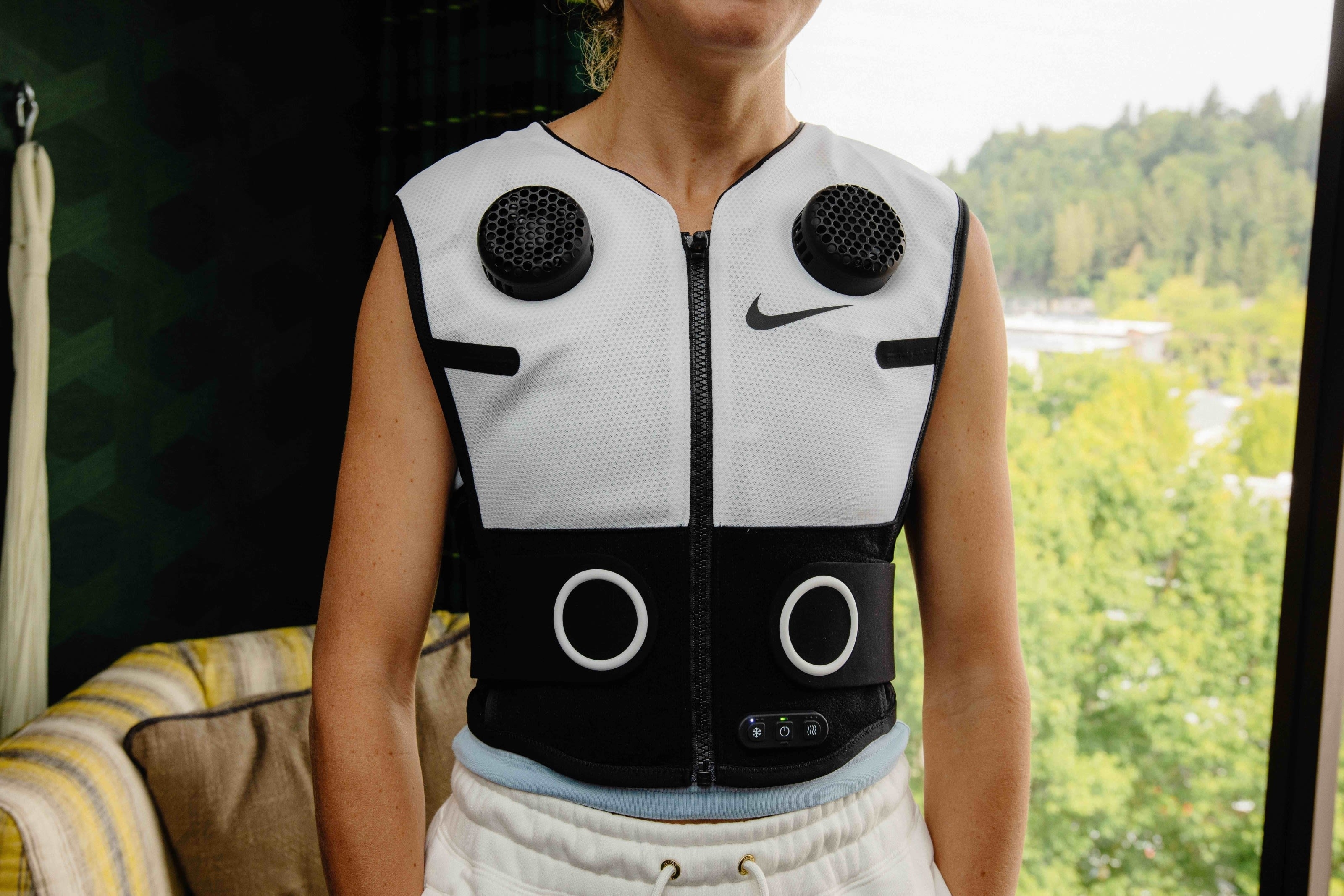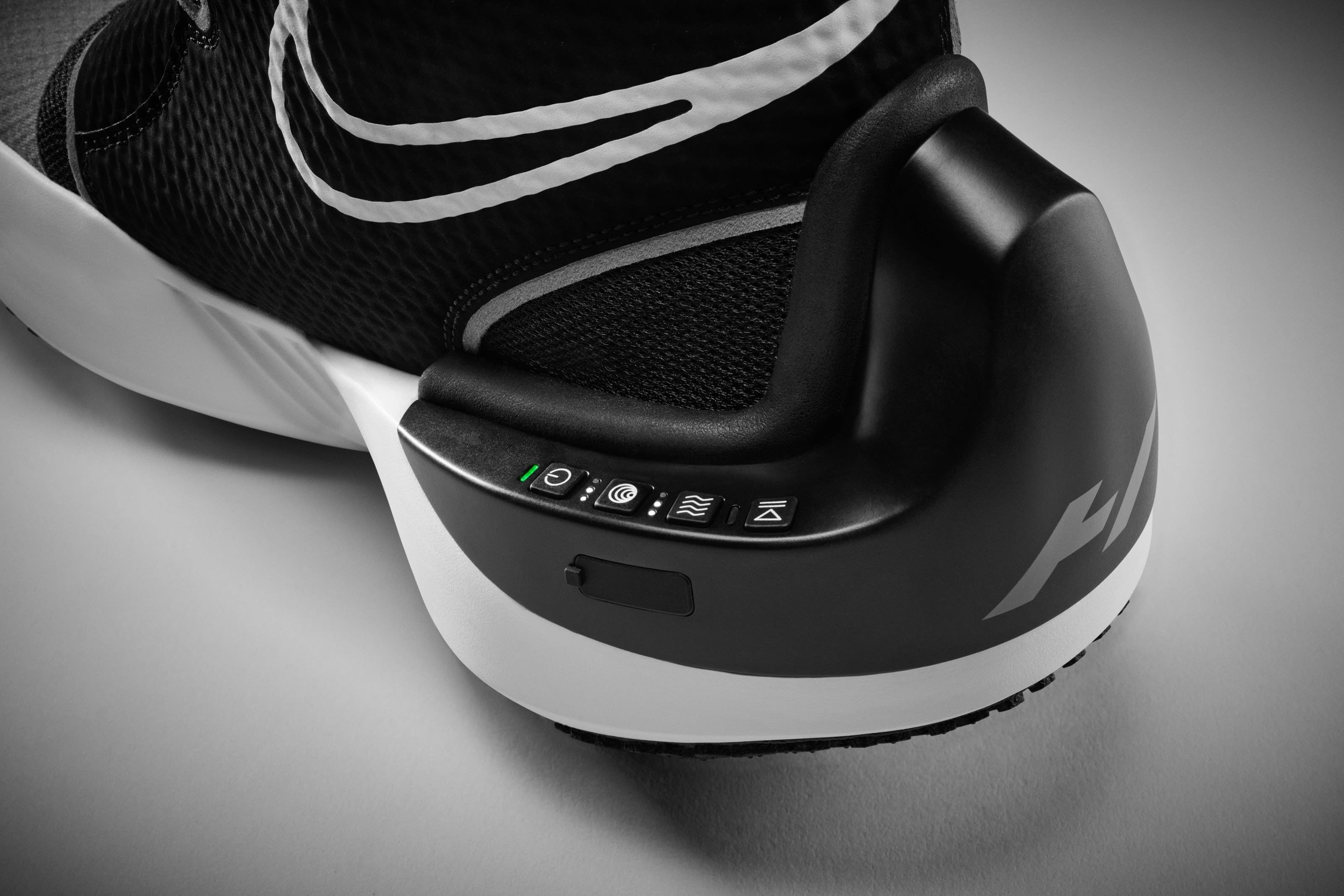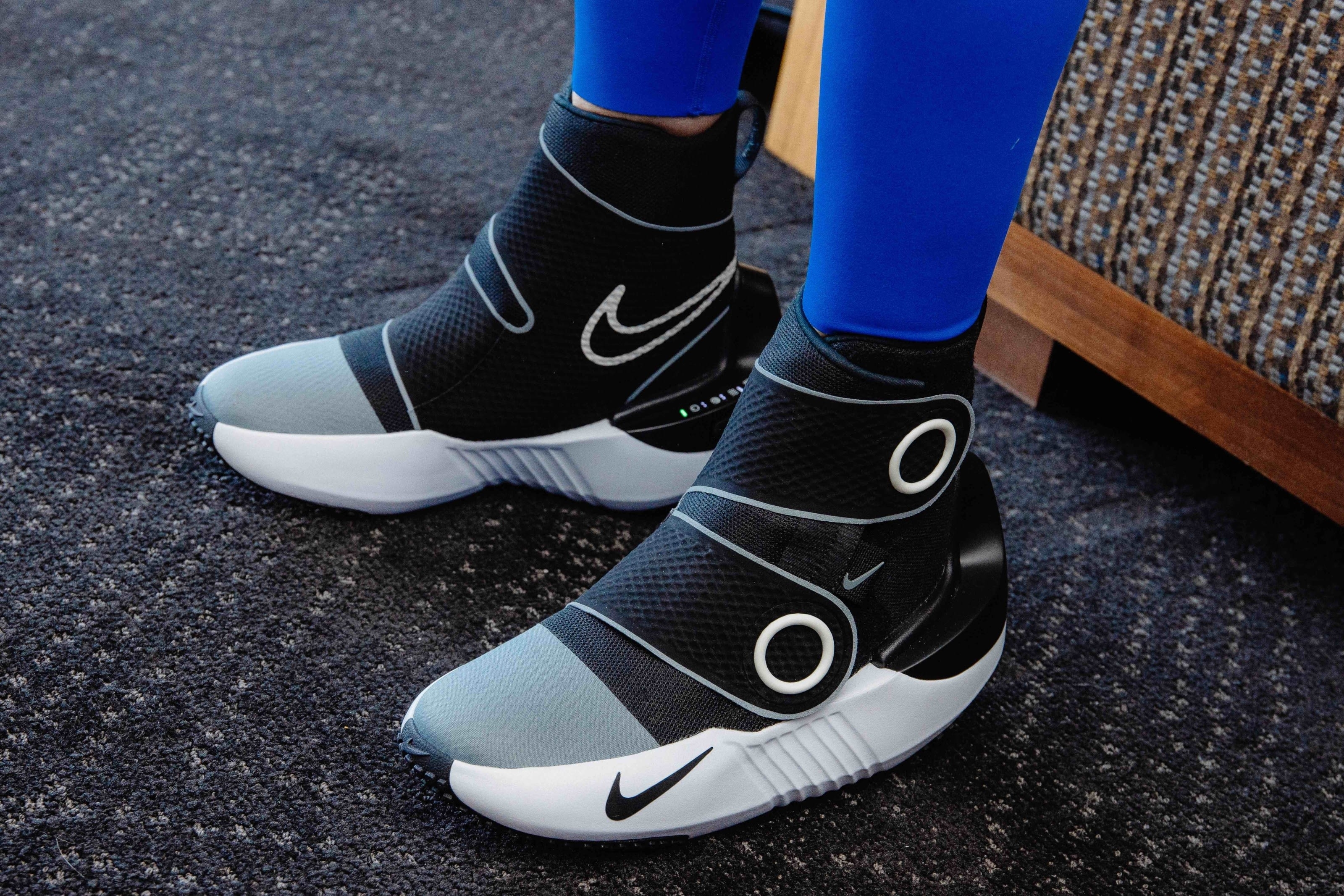
Strapping into Nike’s latest gizmo-loaded shoe doesn’t feel quite like any footwear experience you’ve had before.
You step in the tall boot—a towering silhouette covering much of your calf—and you use two long straps in lieu of laces to harness yourself in, like an astronaut preparing for liftoff. You press the power button toward the heel on the medial side of the midsole for the Iron Man moment; the tech comes alive and the shoe starts to purr. Your foot enters a kind of bionic system, with warming elements and pumping air chambers that massage pressure into your muscles.
Tobie Hatfield, Nike’s senior director of athlete innovation and one of the brains behind the shoe, likens its creation to that of Frankenstein’s monster.
“It was crazy,” he says, recounting the development process with science fiction flair. “You plug it in and you’re literally like, ‘It comes alive.’”

What is it? What does it do? And why are any of these bells and whistles remotely necessary?
The Nike boot (which is still without an official name) was created in collaboration with sports tech brand Hyperice and is meant to supercharge warmup and cool down for athletes.
pack in the thick midsole powers the shoe, which allows for three different degrees of pressure and heat, adjustable across the left and right feet. It’s a bit like wearing a version of the Hyperice NormaTec, those puffy sleeves that inflate and swallow up your legs, that you can actually walk around in. Or having a robot knead at your feet and ankles.
The shoe is big and chunky—if nothing else, it will absolutely make you a couple inches taller. The rounded bends and lines of the space-age silhouette make it look almost like an Apple product. One can walk around in the Hyperice x Nike boot just fine, but you wouldn’t want to try chasing anyone down with them on.
Nike and Hyperice also collaborated on a vest that has heating and cooling capabilities, with thermoelectric coolers doing the work that an ice pack traditionally would.

To Hyperice founder and president Anthony Katz, the shoe is another type of tool for the athlete. He sees the Nike boot as a supplemental piece of footwear for before or after competition—recovery and “pre-covery”—that gets the body closer to optimal performance state. And it could help prevent injury by better warming the wearer up.
“You have to create habits for people,” Katz says, “where it's like, every day using a soft-tissue tool or using the NormaTec becomes brushing your teeth and taking a shower.”
The boot from Nike and Hyperice has some precedent. The sneaker brand has for years made footwear geared toward recovery, but none using electronics to pamper the wearer’s feet. It has released footwear with motors and gadgets inside, like the auto-lacing Nike Mag (designed by Tobie’s brother, Tinker) and the Hyperdapt, but never with the specific intention of recovery.

Those examples of bleeding-edge sneaker technology are well familiar to Nike nerds, if not the general public. Hatfield knows this firsthand from traveling through airports with prototypes of the Hyperice x Nike boots when they were still top secret. The shoes would set off alerts on the X-ray machine at security screening, and Hatfield would have to explain, as much as he could, what they were. But not where anyone else could see them.
“Hey, yeah, if you want to look at it,” he would tell the TSA, “let's go to a private room and take a look at it, bring 'em out. And they did and they opened it up and they were like, ‘What in the world are these?’”
That Hatfield was willing to volunteer for an extra level of scrutiny in some sequestered room in the bowels of an airport is perhaps the best illustration of his dedication to making electronic recovery shoes a real thing.
For now, the shoes are unattainable to the vast majority of the world’s athletes. You can’t have them, at least not until a “later date,” per a press release. (Because what would a Nike debut be without the drama of exclusivity?) Nike plans to outfit around 100 of its endorsers with the Hyprice shoe for this summer’s Olympics in Paris, and will put a few pairs to the test at this weekend’s US track and field Olympic trials in Eugene, Oregon.
LeBron James already has a pair. Eliud Kipchoge has tried them. This writer (who is nowhere near Olympic, world-class, or even modestly accomplished in any kind of sport save for jaywalking) spent about 10 minutes wearing the Hyperice x Nike shoes and vest a few months back.
Ahead of their unveiling, Complex spoke with Hatfield and Katz about the partnership between Hyperice and Nike, the challenges the shoe presented, and why even your grandma needs a pair.
Nike Started From Scratch

The engineering and componentry involved in Hyperice’s recovery tech meant that it wasn’t feasible for Nike to experiment with how it could function in a shoe by just jamming into existing sneakers. It needed new patterns for the upper designed specifically to house all the parts.
“The upper from the get-go had to be brand new,” Hatfield says, “because we're dealing with these air bladders and heating elements and wires and tubes and all that kind of stuff.”
The exception to that was the sole, which is typically the part of a shoe that demands the most resources to create.
“The only thing that we utilized that was existing already at the beginning was the bottom,” Hatfield says. “So we had some existing midsoles and outsoles that we were using just to have some sort of a platform to be on, because that's the one thing that takes the hardest from shoe building.”
Once Nike concluded that the Hyperice tech would work in footwear, it got to work on brand new designs for the midsole and outsole. The two companies began the project in June 2022.
Getting the Technology In

It turns out that the shape of a shoe is less than ideal as a vessel for electronics.
“You don't have a lot of space on a shoe and you don't have a lot of flat surfaces for electronics,” Katz says, “It's really nice when you got real estate and you got a nice flat surface. Shoes—just a bunch of curves.”
What exactly is inside the Hyperice x Nike boot? Katz is careful to point out that, in addition to the warming elements, it’s not one big air bladder squeezing on your foot, but multiple ones working in concert.
“It wasn't just that we wanted compression in the shoe, we wanted the NormaTec technology in the shoe, which is an overlapping system of more than one bladder,” he says. “And so there's zones in the shoe, and what that allows it to do is to compress a part of the shoe and pulse another part of the shoe to release.”
The intent of this pulsing and pumping, he says, is to move fluid and help it circulate. The system is more complicated than most that go into Nike shoes, even for a veteran designer like Hatfield, who’s been with the brand since 1990.
“That was a challenge for us as shoe designers and for them as putting [the technology] into a place that isn't linear,” says Hatfield, “but we just kind of kept going iteration after iteration, and ultimately we were able to get there.”
The collaboration, the engagement between the respective, specialized advantages of Hyperice and Nike, is happening even at a manufacturing level to make the boot a reality.
“There's a couple of factories working together,” Hatfield says. “There's an electronics factory, there's a footwear factory, and they're just working together for the first time, which can prove some challenges for any two factories that haven’t worked together before, but it's going well.”
It Wasn’t Always Pretty

The shoe had to look like a Nike product. Ironically, Katz seems to have been more focused on that in the development process than Hatfield was.
“We weren't going to do this unless we could do it in an elegant way,” says the Hyperice founder. “It's not just: can you just throw a bunch of stuff on it and it looks like a Winnebago with people's bikes and camping stuff all ratcheted up to the side and it's coming down the highway and it's this big monstrosity.”
Hatfield, who has decades of experience transforming sketches into physical reality and burnishing the coarse shapes of ideas into finished, retail-ready products, was less concerned with the look at the onset.
“Any kind of true innovation is, at the beginning, truly messy,” Hatfield says. “And that's actually a good thing, because our first goal is to see is there something here. Our hypothesis, is it really going to start to make a difference? And we don't care what it looks like. We don’t care at the beginning.”
The longtime Nike designer remembers that early versions of the Hyperice boot were distinctly more Frankenstein-like.
The Aha Moment

Cramming a bunch of contraptions into the shape of a shoe does not guarantee a legitimately wearable, helpful piece of equipment for athletes. The people who worked on the Hyperice x Nike boot wanted to make sure they were making something that was functional and fluid in its range of motion. The Frankenstein element shouldn’t extend too far—Hatfield didn’t want wearers lumbering around and losing mobility.
When did Hyperice and Nike finally feel they’d gotten it right? There was a moment, when the loose wires had been tucked away and the tech all onboarded, that convinced Katz it was really coming together.
“I remember Tobie trying them on and walking with them,” Katz says, “and he walked down the hall and turned around and goes, ‘Feels like a shoe.’”
Hatfield felt the compression and the heat himself, but needed more input from outside sources. At one point, during a meeting with Nike’s Advanced Innovation Team at its world headquarters in Beaverton, Oregon, he happened to have an unnamed professional track and field athlete by his side while he was going over the shoe. Could they react to and confirm the sensation of the heating modality, the firm touch of the compression?
“I had the athlete come over,” Hatfield says, “and they tried it and they're like, ‘Oh my gosh.’ Because we want it to work, we’re biased. It was just like: I'm biased. Athlete comes by, had no idea what in the world—just really out of the blue—and just put it on their feet, on their foot, just one foot. And then they said, ‘Yeah, I would use this right now. This is amazing.’”
Not that the project will always only be about elite athletes. Hatfield believes in the Bill Bowerman dictum and Nike slogan that if you have a body you’re an athlete, and believes the Hyperice boot won’t only be useful for Olympians.
In fact, another of the professional athletes who he had triliang the shoe confirmed for him just how widely it could be adapted for anyone looking to increase recovery and circulation.
“They said, ‘I love this and I’m using it, and it’s great.’ Kind of like a thank you,” Hatfield says. “Then there was the, ‘But, I want this on my grandma right now.’”

